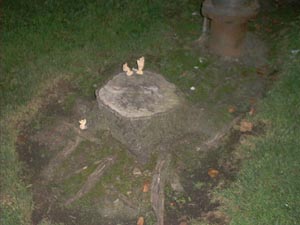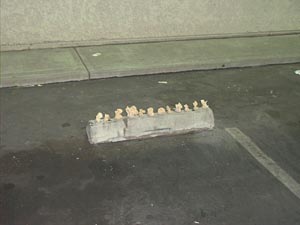2022
Pysanky for Peace
In early 2022, Putin invaded Ukraine. Other San Francisco Bay Area women and I launched “Pysanky for Peace,” with the motto “Make Eggs Not War!” This started out as a way to process our feelings about the invasion, as many of us have Eastern European heritage. Then a few ambitious artists turned our efforts into a fundraiser. Via a storefront window in Berkeley’s Elmwood district, and a silent auction, we raised over $5700 for humanitarian aid for Ukraine using our artful eggs. Viva la feminine!
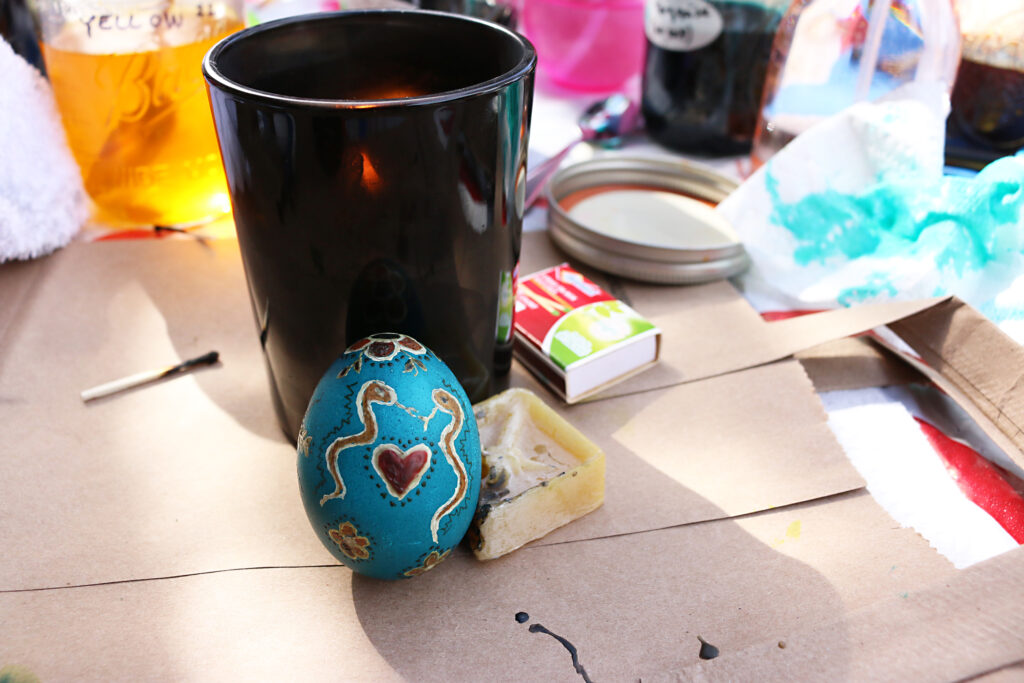
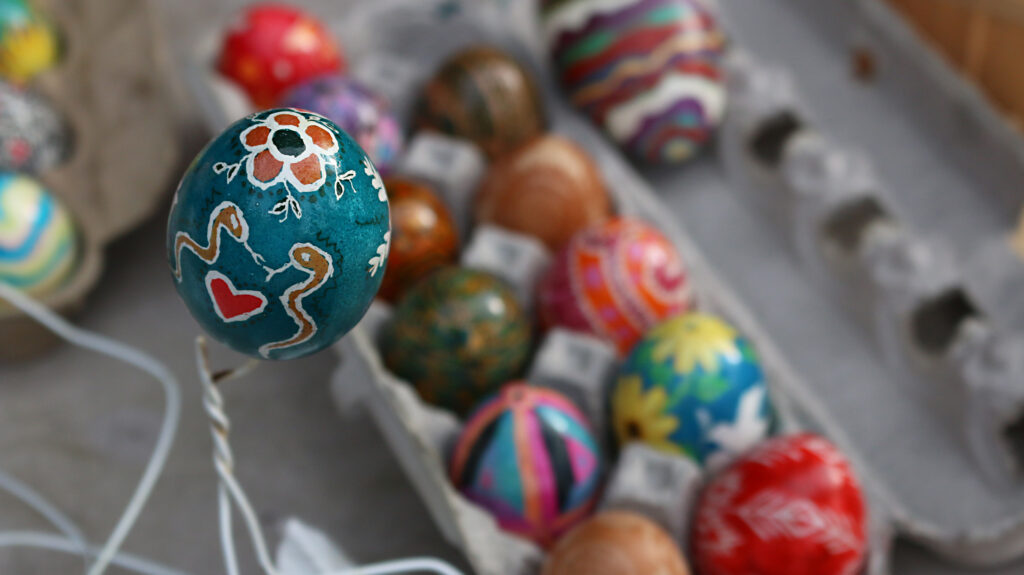
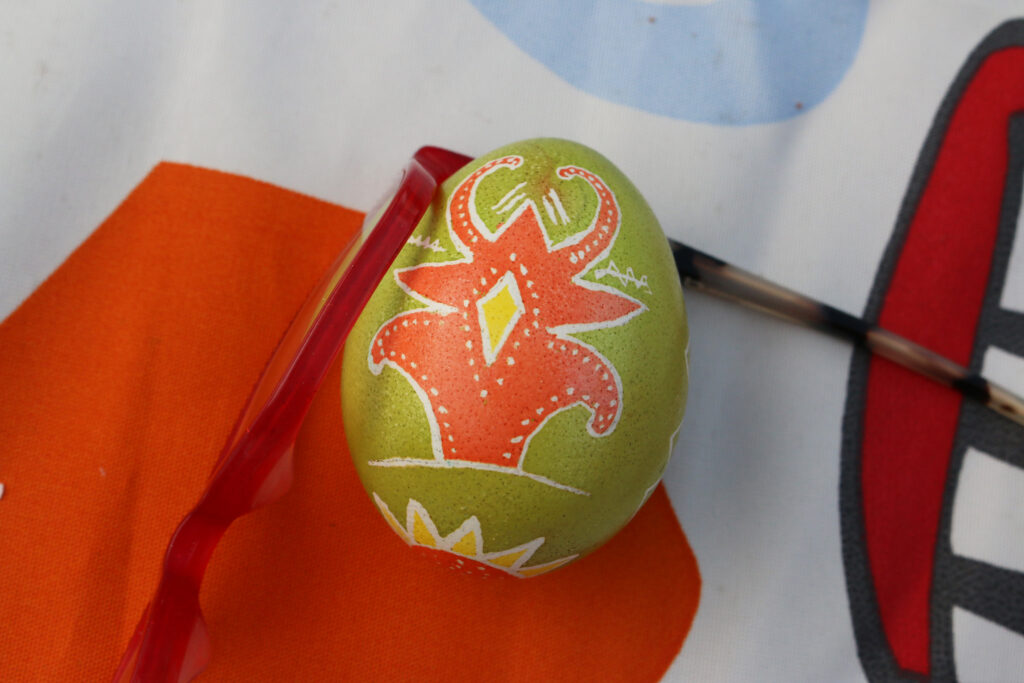
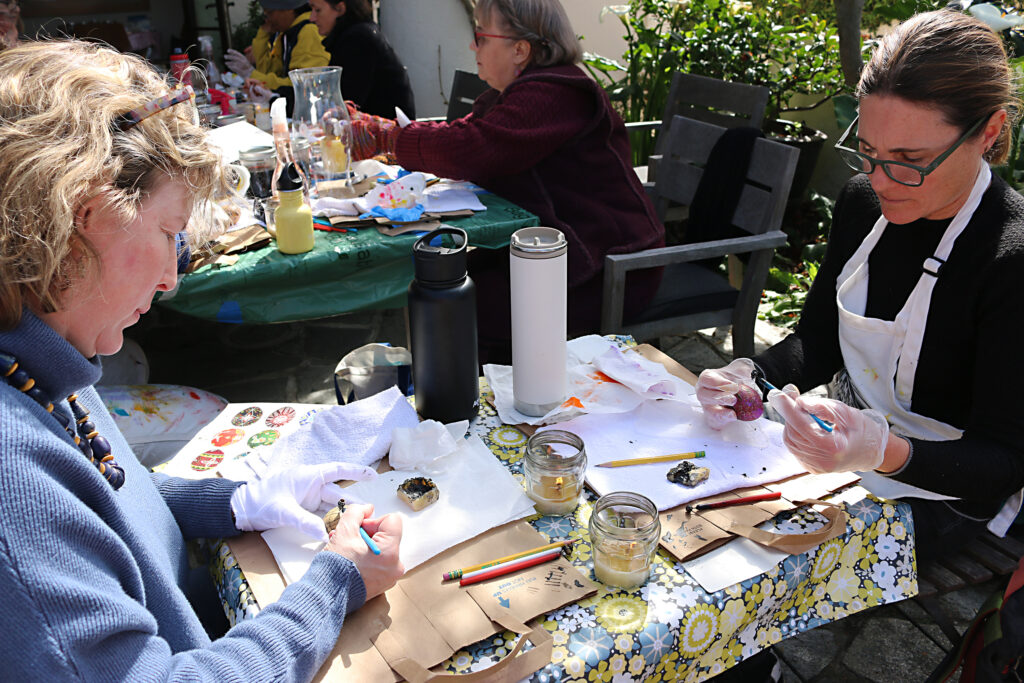
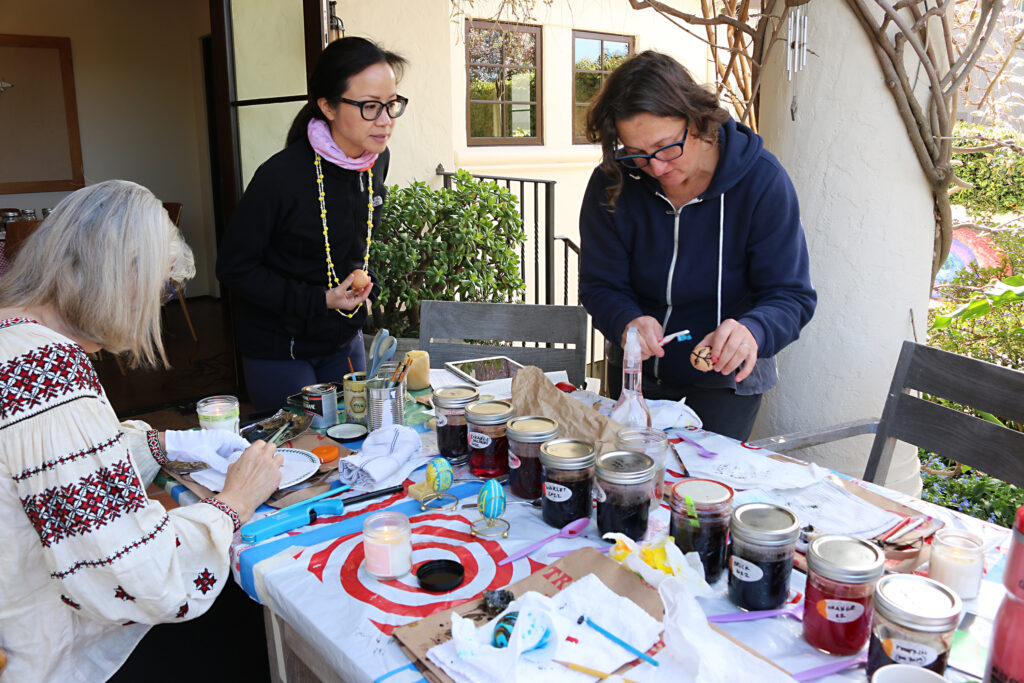
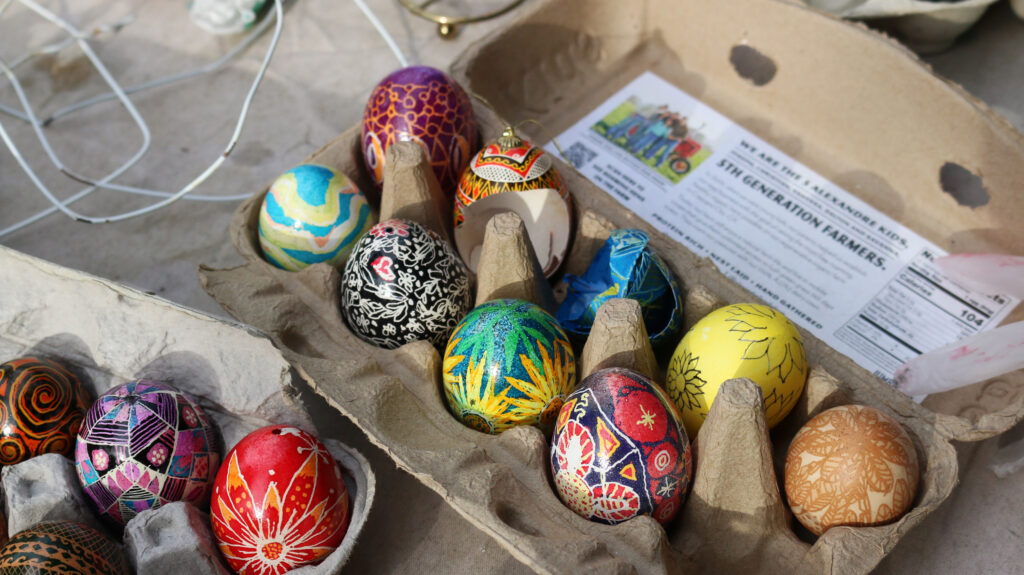
2006
New York Times Data Mapping Piece
The New York Times Data Mapping Project was a visual representation of New York Times headlines for the month of January, 2006. It sought to expand the definition of data visualization to include sculpture and performance.
I represented each category of New York Times headlines, such as “International,” “NY/Region,” or “Technology” with a stuffed doll-like figure made from a different pattern of fabric. Figures were also differentiated and separated by gender, as expressed by the names of headline article journalists. Where the gender was not obvious to me, such as “Robin,” I researched that author to confirm his or her gender. Associated Press articles were eliminated from the data set, since they were not specific to the Times. This project assumed that any transgendered journalists, if there were any, expressed their gender identity through their names. This may or may not have been an accurate assumption. All data was culled from the New York Times online addition, generally around 7 am Pacific Time/10 am New York time.
The final data tally showed that about 22% of headline authors were female, and this tally would have been lower if there had not been a spike of articles written by women for the few days around the confirmation of Judge Samuel Alito to the Supreme Court. The final data set might also reveal something about what topics were most important to readers of the New York Times at that time. For example, a comparison of the number of Technology headlines in the New York Times relative to the number in the San Jose Mercury News might potentially yield relevant information about audience demographics.
This piece was interactive in that I encouraged people installing it to experiment and push for as many patterns for representing the data as possible. Here I show two simple possibilities for arrangement, a floor grid (with females on top) and a floor pie graph (with females on the left).
Project documentation link: http://www.pelefire.com/nytimes/ (includes raw data graph and more photographs)
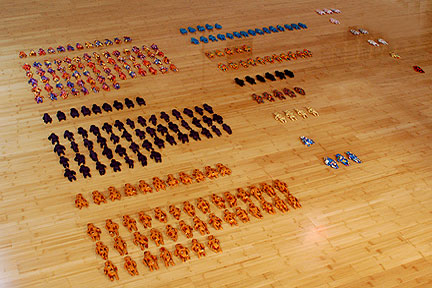
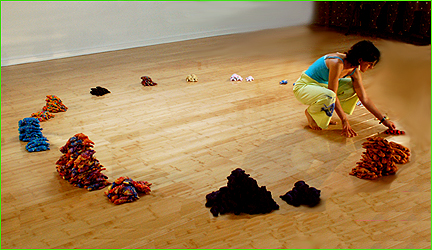
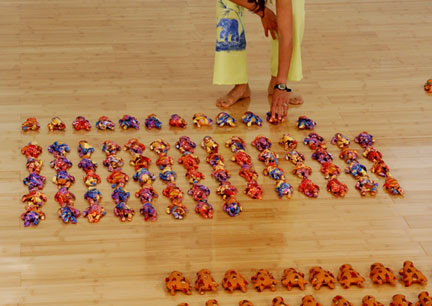
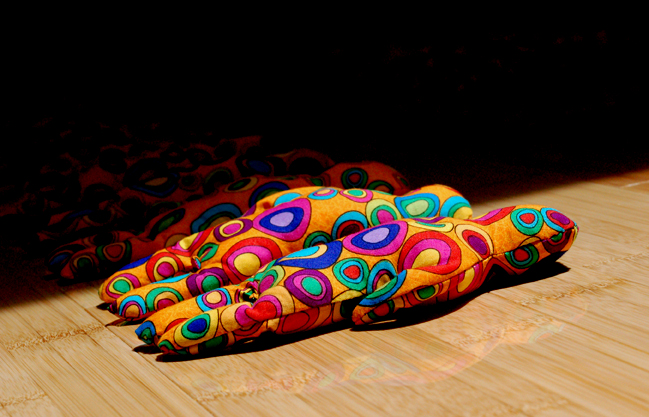
2002
“Making Friends” Life-Art Performance
Before returning to graduate school for my MFA, I worked at the Center for Middle Eastern Studies at UC Berkeley. While at Berkeley I had the fabulous opportunity to meet and interact with prominent scholars and political figures from all over the globe who focus on topics pertaining to Middle Eastern cultures. From Sufi Poetry to the architecture of Medieval Cairo, the economics of Morocco to the complexities of the Israeli/Palestinian conflict, every day I learned something new or garnered a new perspective. In the middle of my time there, the terrorist attacks on America reshaped the country’s consciousness and the corporate media intensified their long tradition of creating suspicion of Arabs and Arab-Americans, especially those who practice Islam. And the threat of The Gulf War: Episode II was looming on the horizon made smoggy by burning oil.
My experiences at Berkeley influenced a lot of my art, including a trilogy of performances that sought to serve as a barometer of attitudes in San Francisco towards the prominent “Other” of that time. These performances also sought to erode the manipulated lines of separation that divide us as human beings.
In the life-art performance pictured here, I played with signifiers to confront people in their stereotypes. Faced with the dilemma of how to document a performance without calling attention to its screws and stretcher bars, I opted to have tourists document it for me! I went to Fisherman’s Warf and the Golden Gate Bridge (where a military hummer pulled into the parking lot behind me) wearing a head scarf and a ruffled shirt covered with red, white and blue stars and stripes. Any time I found a good photo op or anytime people started giving me questionable “looks,” I confronted them with friendliness, engaged them in small talk, and asked them to please take my picture. A camera, it seems, serves as an ice breaker in most corners of the globe, even in our own back yards.
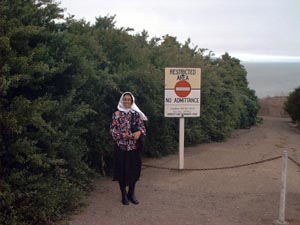


Months later, I created postcards from the photos that tourists took. I wanted to question the idea of borders and boundaries via something that we assume to transverse them freely, the U.S. mail. I had this idea because, after 9-11-2001, the post office held a book from my Chair at CMES to the CMES Chair at another university. It was a really subversive book–on Medieval Islamic architecture.
Fleet Week Peace Action
For chapter 3 of my performance trilogy, I decided to work collaboratively with artist Kevin Cain. It made sense, in this piece, to bury individuality and ego, and to promote a partnership model in contrast to the dominator model that we were protesting through our action, which was really, really subversive:
We defied the sanctimony of capitalism by GIVING AWAY refreshing lemonade to hundreds of people, right under the nose of a military sharpshooter with a very big gun, poised like a rooftop sniper, and right in the midst of the Navy and Marines.
It was Fleet Week in San Francisco, and I saw a great opportunity to make a fuss about where this country was heading in regard to the propagation of the war machine.
Fleet Week is when thousands upon thousands of people flood San Francisco from all over to watch big noisy fighter jets burn tax dollars in mid air. It is supposed to foster pride in phallocentric displays of military might. So we had to consider our audience. Any sort of radical action that I would normally feel compelled to do would merely set up the walls of an us/them mentality, and that is the very same mentality that creates and allows for war. We had to think of something subtle and non-confrontational, something that brought people closer instead of dividing them. Yet we wanted to get across a message, or even a few. And we had to think of it on the spur of the moment, because that is where the performance opportunity was.
We decided that we should try to create community; how about by giving? Kevin suggested lemonade, such an all-American symbol. I pushed for pink lemonade, because it is girly and girls don’t (generally) make war. I also thought it just hinted at blood, and blood goes with war. Kevin liked the idea that it mirrored the gesture of an Arab tradition of hospitality, giving water from a sacred urn to those traveling under the hot sun. It also bridged Islamic and Christian stories/values of charity. So the piece worked for us on an internal level as a meditation on service and giving and sharing and all those high ideals of spiritual paths. I also liked the innocence and purity of a lemonade stand, the ideals of childhood being so counter those ways of the world that spark war.
Our little twist, though, was drawing peace signs on the outer bottom of each paper cup that we handed out. Again, it is a simple innocent gesture, but because of its simplicity it was very direct. You could not see the peace sign so easily while drinking, until the last sips. Each time you tipped your cup to your mouth, though, you flashed a peace sign to someone else. Kevin directly approached a lot of sailors and gave them drinks, and they were all unknowingly tipping peace signs to those around them.
Costuming was carefully considered, too. I wore the same patriotic flag-covered shirt that I wore with a headscarf in my last performance/action. This was in part to be more accepted by and approachable to this crowd. However, it was also a way of saying that there are other methods of being patriotic than shopping and bombing. I wore my hair in handle bar pigtails. This was in part to go with the innocence idea, but it was also a nod to an ancient Mesopotamian stele depicting Innana with her hair in that style. I certainly did not expect anyone to pick up on that, but it worked for me as an invocation. –or maybe she was the one invoking my help, since Mesopotamia is now Iraq, and it is the land of Innana that was about to be decimated. Kevin wore a Hawiian shirt that read as, “Hi, am an easy-going approachable guy next door.”
The piece was a huge success. People just could not believe that we were just GIVING something to them, showing just how competitive capitalist values are so ingrained in us that we have trouble believing that another paradigm could even exist! One man started to get really angry with us when he saw the peace sign at the bottom of his cup. He was walking towards us to confront us, then for some reason stopped and let it go. And the local news interviewed us! I do not know how many people connected all the dots to think about the relationship between greed and war, and stopped to consider that subverting greed might be a way to subvert conflict. Hopefully, though, each person who stopped at our little lemonade stand had a moment of experiencing peace as they shared in an exchange based on respect and caring. Everyone but the one angry man seemed so appreciative, hopefully we set a cycle in motion.

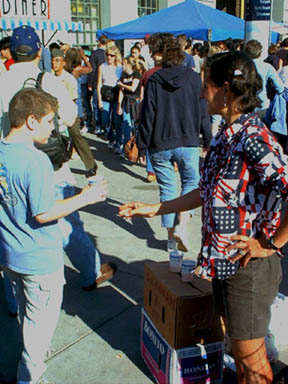
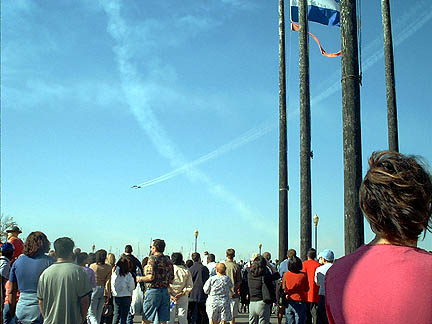

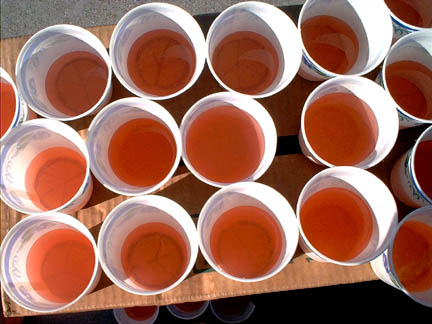
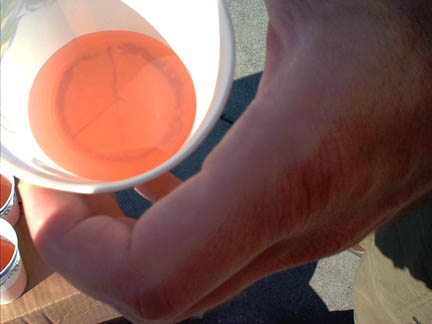
Muwekma Memorial Project
The Muwekma Project was a guerrilla art action that honored the Native Americans buried in the Emeryville shell mound, a site thought to be 2500 years old. At the time of this action, a strip mall of chain stores had newly opened on top of them. Before construction began, crews recovered 23 skeletons, 300-400 beads and 2 funerary objects. To recognize the indigenous people at this site, under the dark of night I strategically placed small pouches of organic Native American tobacco–a typical offering of the indigenous people of the San Francisco Bay area–on what had become corporate property. I died the fabric for the pouches with local herbs. With the pouches I engaged in spatial dialogues at the site of the shell mound and imagined a spiritual dialogue with the original inhabitants of that land.
For more about the indigenous people of the Emeryville area, see: https://www.ci.emeryville.ca.us/657/Indigenous-People

